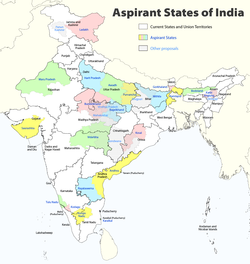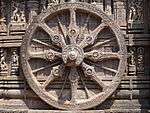Western Odisha
Western Odisha is a territory in western part of Odisha, India, extending from the Nuapada district in the south to the Sundargarh district in the northwest.
History
- Keling (Kalinga)
First empire which used to rule complete Odisha along with Chhattisgarh before Gupta Mourya invasion of Odisha in which Ashoka won Kalinga ruled Orissa along with India.
Ashoka Defeated Kalinga and ruled it after the bloodiest and famous Kalinga War.
- Soma Dynasty
Many small kingdoms, ruled by local chieftains, existed in ancient times, in what is now called Western Odisha. Tibardeb of the Soma dynasty, whose capital was at Sripur, in Chhattisgarh was the first ruler, who defeated all these chieftains and established a large kingdom in Dakhin Kosal comprising what is present day Chhattisgarh. Somavamshmi captured western parts of Odisha which was ruled by Gupta and Mourya who defeated Kalinga Empire.
- Eastern Ganga Dynasty
'Anangbhim Deb' of the Ganga dynasty of Kalinga, again won his territory back and somavamshmi probably merged his dakshin kosala with Odisha.
- Chola Dynasty
'Yasoraj', an army commander of 'Rajendra Chola' of the South, conquered Sonpur in 1040 and ruled Western Odisha. Four rulers of this dynasty ruled until 1110.
- Kalachuri Dynasty
Jajalla-deva, a ruler of the Kalachuri dynasty of Ratanpur, defeated the ruler of Sonpur and annexed it with his kingdom in 1110. It was under the Kalachuri rulers of Ratanpur (Now in Chhattisgarh state) from 1110 to 1238.[1] Thus, South Kosal again remained as one unit. South Kosal (Chhattisgarh) were united and ruled by the Kalachuri rulers of Ratanpur.
Separate Kosal state movement
People of Western Odisha mainly intelligentsia, members of political parties, and various social organisations, are demanding the creation of a separate Kosal state, comprising the western part of the State of Odisha.[2][3] The area of the proposed Kosal state is more than 50,000 km2, which is comparable to the areas of Kerala (33,883 km2), Haryana (44,212 km2), Punjab (50,362 km2), Uttranchal (53,483 km2) and Himachal (55,673 km2). The movement is ongoing with the involvement of political parties and various groups of intellectuals.[4]

Geography and climate
Geographically, this tract of land is mostly mountainous and hilly, interspersed with rivers and valleys. Rivers Mahanadi and Brahmani are the major rivers flowing through Kosal region. Tributaries of river Mahanadi that flow through this region are Ib, Jeera, Ang and Tel. Western Odisha has many mountains, chief mountain peaks among them are Bankasam (1275 metres), Tangri Donger (1229 metres), Baphlimali (1220 metres), Champaghara (1257 metres), Murali soru (1223 metres), Doda soru (1157 metres) in Kandhamal district, Nrusinghnath (786 metres) in Bargarh district, Debrigarh (680 metres) in Sambalpur district, Badpati of Loisingha (690 metres) in Balangir district, Mankadnacha of Bonai (1090 metres) in Sundargarh district, Katpar of Khariar (970 metres) in Nuapada district.
Natural resources
Western odisha region is rich with minerals. Iron ore is available in plenty at Tensa and Barsuan in Sundargarh district, Bauxite is available in Niyamgiri and Karlapat in Kalahandi district, Gandhamardan in Bargarh district, Khariar in Nuapada district and Baphlimali in Rayagada distinct. Coal is available in Himgir in Sundargarh district and Rampur in Jharsuguda district. Dolomite is available at Dubulabera and Kangorama in Sambalpur district and Lephripada in Sundargarh district. Graphite is available at Patnagarh and Titilagarh in Balangir district. Manganese ore is available in Nuapada and Balangir district. Fireclay is available at Belpahar in Jharsuguda district, Gandawara in Sambalpur district and some places of Sundargarh district.[5]
Demographics
Population
| District | District Headquarters | Area (km2.) | Population 1991 Census | Population 2011 Census | Literacy Rate 2011 |
|---|---|---|---|---|---|
| Balangir | Balangir | 6,575 | 1,230,938 | 1,648,574 | 65.50 |
| Bargarh | Bargarh | 5,837 | 1,207,172 | 1,478,833 | 75.16 |
| Nuapada | Nuapada | 3,852 | 469,482 | 606,490 | 58.20 |
| Sambalpur | Sambalpur | 6,702 | 809,017 | 1,044,410 | 76.91 |
| Subarnapur | Sonepur | 2,337 | 476,815 | 652,107 | 74.42 |
(Source: Population of India, 2011)[6]
In addition to the ten districts listed above and shown on the map, the Western Odisha Development Council includes Anugul on its website.[7]
Western Odisha contains 24.34% of the total population of the Odisha state. Tribal populations comprise 40% of Western Odisha's total population. The Agharias, a community from north-western Uttar Pradesh, make up close to 10% of the population in the area. 23.38% of Odisha's Scheduled Caste population and 33.9% of its Scheduled Tribe population reside in this region. The area supports 29.75% of the Odisha state's economically backward people, 25.8% of its cultivators, 27.52% of its agricultural labourers, 32.18% of its household industrial workers, 25.36% of its workers overall, 30.54% of its marginal workers and 22.87% of its non-workers.
Art and culture
Western Odisha is culturally influenced by several different cults and religions. Its history dates back to the Mahabharat and Buddhist period. Folk songs and dances of this area have been revived and recognized during the last quarter century, including Danda (Danda Yatra and Danda Nata), which is considered to be one of the oldest forms of variety entertainment in India, to the modern "Krushnaguru Bhajan", a type of folk lyrics and songs. Sambalpuri language songs are quite popular throughout Odisha. Some hits include Rangabati, Ekda Ekda, Dalkhai, and Panbala Babu.[8][9]
Songs and dances
Rangabati
Rangabati is a modern composed Sambalpuri song inspired by folk music, written about 1975, which enjoyed international popularity in the 1970s and 1980s. It was sung by Jitendra Haripal and Krishna Patel. The music was composed by Prabhudutta Pradhan and the lyrics by Mitrabhanu Gauntia. The song was recorded and broadcast by All India Radio, Sambalpur[10]
The Sambalpuri saree
The Sambalpuri saree is made from fabric woven on a hand-loom, and is popular throughout India.[11] Sambalpuri Sadhi & Other Clothes are made in Brahmanpada, Nuapada
Nuapada district. it's locally known as Brahmanpadia Sambalpuri Clothes. & Bargarh District
Notable persons of Western Odisha
- Bhima Bhoi
- Gangadhar Meher
- Parbati Giri
- Prem Ram Dubey
- Bhubaneswar Behera
- Veer Surendra Sai
- Satya Narayan Bohidar
- Haldhar Nag
- Prayagdatta Joshi[12]
- Sam pitroda
References
- Dash, Siba Prasad, " Sambalpur Itihas ", Odisha Sahitya Academy, Bhubaneswar, 2002, ISBN 81-7586-083-9, P. 68,70
- "Demand For a Separate Kosal statehood". The Hindu.
- "Demand for Kosal state gaining Momentum". cfnonline.
- "Kosal Kranti dal, political party demanding for separate kosal statehood". OneIndia.
- Mohanty, Basanta Kumar, Orissa Fact File, 2005, p.46
- Population of Western Orissa
- WODC main page
- Current Sambalpuri Album
- Legendary Sambalpuri singer Jitendra Haripal
- "And the singer sings his song ", The Hindu, 27 May 2001.
- "Sambalpuri Sari: Living tradition ", Merinews.com, 20 November 2008
- Sudeep Kumar Guru (25 September 2010). "Poetry makes him known as new Gangadhar Meher". The Telegraph (India). Ananda Publishers. Retrieved 4 November 2010.
